The Chromebook Pixel (2015) Review
by Brandon Chester on March 16, 2015 8:00 AM EST- Posted in
- Laptops
- Chrome OS
- Chromebook
- Chromebook Pixel
Display
When the original Chromebook Pixel launched two years ago, its big selling point and the source of its name was its 239ppi 2560x1700 display. At that time, the only other laptops on the market with HiDPI displays were Apple's Retina MacBook Pros. Chromebooks have typically aimed for the low-cost segment of the laptop market, and so it was quite a surprise that one of the earliest HiDPI laptops was a Chromebook. Although the Pixel had the highest pixel density of any laptop display at the time, it fell somewhat short when it came to color reproduction due to its narrow color gamut and lack of calibration. With the new Chromebook Pixel, Google has advertised coverage of the sRGB color gamut, along with a maximum brightness of 400nits.
To see whether or not Google has hit their mark, we turn to our standard display testing workflow. As usual, all measurements are performed using SpectraCal's CalMAN 5 software along with X-Rite's i1Pro 2 spectrophotometer, with the exception of black level measurements which are performed with an i1Display Pro colorimeter.
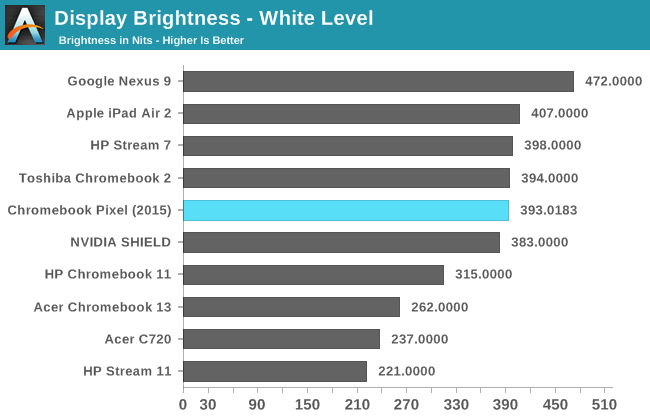
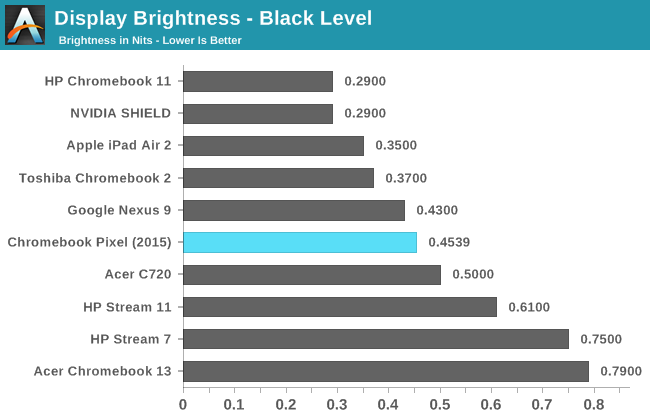
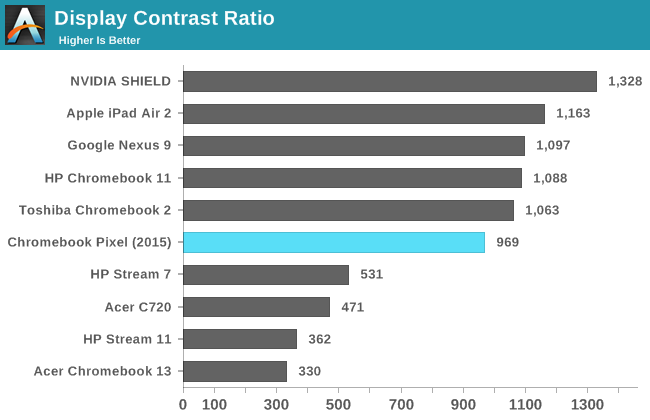
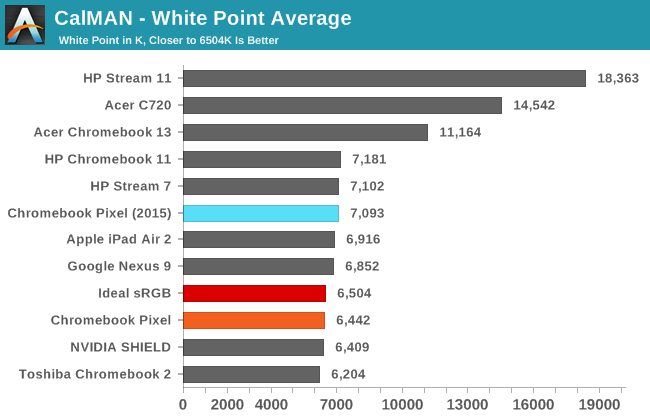
Due to the evolution of our display workflow as time has gone on, I don't have results to compare the new Pixel to the original for certain categories. The result for maximum brightness is certainly in line with Google's advertised 400nit brightness, while the black levels and contrast ratio are what you would expect of IPS panels. The white point is noticeably more blue than the ideal D6504 target, which contrasts with the original Pixel which was very slightly too red. The blue/green tint in white and shades of grey is also more obvious than most other devices with similar average white points, which I elaborate on further below.

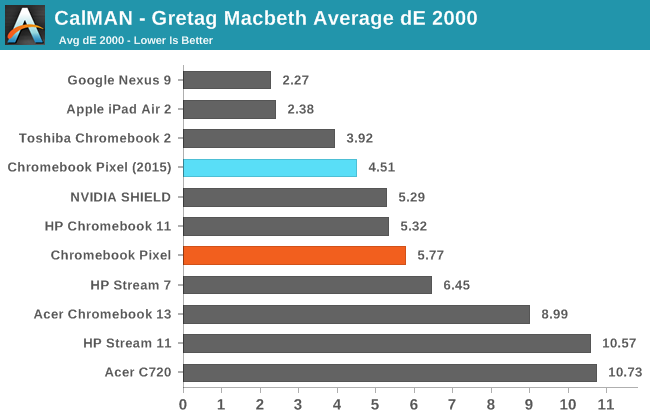
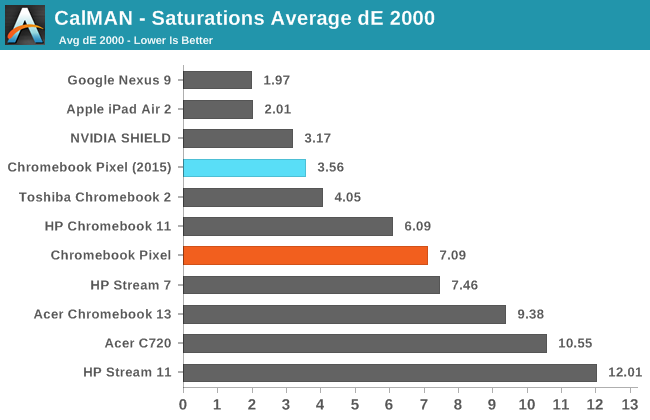
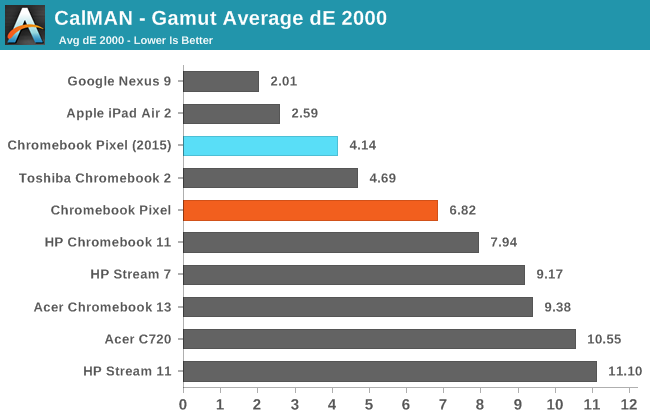
The new Pixel improves significantly upon the original in the gamut and saturation tests. It has a much wider gamut than the original, although it misses in magenta and yellow. Saturation improvements follow the improved gamut, as colors of 80% and 100% saturation no longer look identical. Despite these improvements, there hasn't been much progress on greyscale and color mixture accuracy. As noted earlier, the Pixel has a fairly obvious green/blue tint to the lighter shades of grey and white. As you can see in the gallery below, this is due to the reduction in red and increase in blue components of luminance as the shades of grey move from black to white.
I don't expect that many Chromebook users will be doing heavy photo and video editing that requires a perfectly calibrated display. Many $999 laptops ship with displays that are much worse than the one on the new Pixel, and I think that most users will be very happy with the Pixel's display. It's just a shame that Google doesn't seem to have put the same amount of care into display calibration with the Pixel as they have with the Nexus 9 and other Google branded devices, despite it having the highest price point of the devices they sell.
















123 Comments
View All Comments
Sushisamurai - Monday, March 16, 2015 - link
Just nit picking, but for the battery / charge time section, I think you should add a chart for normalized values, to compare efficiency - I think it'd be neat to see how efficient these new laptops are getting (it's the new trend!)Sushisamurai - Monday, March 16, 2015 - link
But yeah, cool read. If it didn't have chrome book logo written on it, i think I might just mistake the keyboard/trackpad design for a Macbook design. The body could use some contours IMO. That LED light bar is a novel ideaandychow - Monday, March 16, 2015 - link
My only real complaint is the lack of "page-up/page-down" buttons. They had the space left and right of the "up" button. I use those a lot normally. I know you can do alt-up or alt-down, but, I would like those buttons.Otherwise, great device that fixes the only real problem with the first one: the battery life.
I can't find this on the google store, but as soon as it's there I'm buying one.
Brandon Chester - Monday, March 16, 2015 - link
Are you in the US or UK? It should be available there right now.melgross - Monday, March 16, 2015 - link
"All these little details result in a really unique design, and its been clear since the original Pixel that Google wanted to create their own device instead of just carbon copying another laptop"Well, as this looks almost exactly like a Macbook Pro to most people, I wouldn't say that it's so original. It seems that to pc makers, and now this extends to Google's Chrome efforts, being "original" means copying Apple (again).
Yes, I expect to get flamed here, but that doesn't change the facts.
Brandon Chester - Monday, March 16, 2015 - link
I have both Retina MacBook Pros and the Pixel is distinctly different in many ways.aliasfox - Monday, March 16, 2015 - link
As someone who's seen and used a variety of different MacBooks as well as the first generation Pixel, I'll say that if a Retina MacBook Pro makes the average laptop look cheap and chintzy, then the Pixel makes the rMBP look and feel like a low-effort design. The Pixels that I've handled and seen seem to have tighter tolerances and lower torsional flex than even the unibody MacBooks, which make them seem even more 'hewn from one piece of metal' than Apple's products do.In terms of look and feel, if the average laptop was a Toyota Corolla and a MacBook Pro was an Audi A6, then the Pixel is like a Mercedes Benz S-Class. It really is very noticeable.
MykeM - Tuesday, March 17, 2015 - link
Knowing Mercedes, the attention to details cover more than just the exterior design but also the engine or the engineering throughout the entire vehicle. If you look at the typical Mercedes, it would look something like this:http://i.imgur.com/DQg0bp4.jpg
Now if you look inside a Chromebook, you'll see this:
http://i.imgur.com/V9BVu2N.jpg
http://i.imgur.com/ZnK3YTJ.png
And compare it to the inside of a Retina MacBook Pro:
http://i.imgur.com/O5LcAHg.jpg
Now tell me again which of the two is the Mercedes and the Toyota Prius?
http://i.imgur.com/Ua07lwU.jpg
Braincruser - Monday, March 16, 2015 - link
This is a price range for many gaming laptops. Infinitely more powerful, better storage AND better facebook machine.MantasPakenas - Monday, March 16, 2015 - link
Nice review. However, I see a couple of glaring issues I'd like to see addressed:Even though you criticize the Pixel, even if indirectly, for running a somewhat limited OS for this price bracket, you (and to be fair, most other reviewers) fail to mention it's one huge advantage (given the limitations) - killer security features and 0 hassle with updates or almost anything else OS related. That's worth a lot to a lot of people, even if most of them look for something much cheaper.
Pardon, but I just don't see how benchmarking the Pixel against tablets and vastly cheaper and inferior Chromebooks makes any sense at all. This is, after all, an ultrabook, and one costing $1000 or more. These benchmarks give me somewhere around 10% of (somewhat) useful information, and omit the 90% of the really important one. I can understand how including one or two more powerful Chromebooks makes sense as a baseline, but this laptop has a display, battery, and processor that needs to be compared only agains Macbook Pros, Airs, Lenovo Yoga Pros and Dell XPS 13s! Especially since this is targeted at developers and these guys are more than likely to run at least Linux on it, doing most of the same tasks they would do on their Windows or OSX machines.